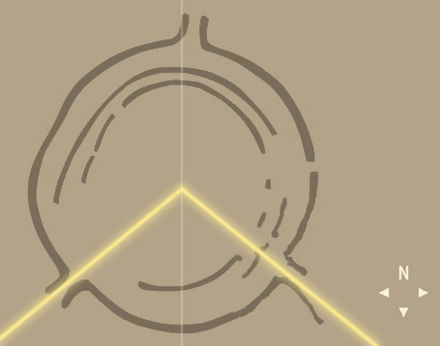Goseck Circle
The Goseck Circle (German: Sonnenobservatorium Goseck) is a Neolithic structure in Goseck in the Burgenlandkreis district in Saxony-Anhalt, Germany.
Its construction is dated to approximately 4900 B.C., and appears to have remained in use until about 4700 B.C. Thus, it may be the oldest and best known of the circular enclosures associated with the Central European Neolithic. Currently, the site is presented officially by the state archaeologists and the local association that looks after it as a ritual or cult structure.
The circle consists of a concentric ditch 75 metres (246 feet) across and two palisade rings containing entrances in places aligned with sunrise and sunset on the winter solstice days and smaller entrances aligned with the summer solstice. Marketing materials have described the site as one of the oldest "Solar observatories" in the world, but sunrise and sunset during winter and summer solstices are the only evident astronomical alignments emphasized in the remains of the structure.
The existence of the site was made public in August 2003. It was opened for visitors in December 2005.
The site is located on farmland near Goseck, in the Burgenlandkreis of Saxony-Anhalt, between Naumburg and Weißenfels. The circle sits on a piece of land that gradually rises toward the south, not far from where the Unstrut flows into the Saale, at the border of the region known as Leipzig Bay.[1]
The circle was discovered in 1991 by Otto Braasch on an aerial survey photograph that showed circular ridges under a wheat field. The cropmarks were easy to see in a season of drought. The structure's visibility also indicated an advanced state of erosion.[1]




